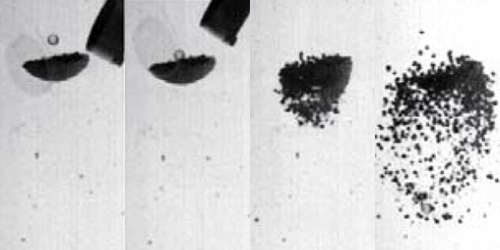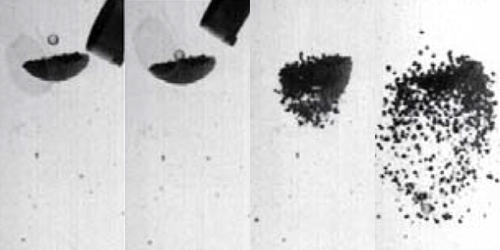Throwing Dust at Planet Formation
A cloud of dust swirls in the expanse of space, and somehow a planet is born. Much is still poorly understood about this process, but astrophysicists can conduct free-fall experiments to gather clues. Using a 1.5-meter-tall drop tower in their earthly lab, Hiroaki Katsuragi of Nagoya University, Japan, and Jürgen Blum of the Technical University of Braunschweig, Germany, dropped a bead into a clump of particles under vacuum conditions like those in space. Photographing multiple collisions at 3000 frames per second, they found that they could derive rules that applied to all the collisions, regardless of the beads and particles used. Although the target clump broke apart in this simple experiment, understanding this process can help explain how planets stick together.
In their experiments, Katsuragi and Blum dropped a millimeter-sized bead from the top of the tower. Next, a few centimeters below the bead, they quickly released a cup-sized clump of millimeter-wide dust particles. The bead crashed into the clump, breaking it apart. A camera falling along the outside of the tower captured the collision.
The duo repeated this experiment with various sizes and combinations of a plastic, glass, or lead bead and dust- or glass-particle clumps. Analyzing the images, they found that, regardless of the bead or particles used, the collision transferred about 5% of the bead’s kinetic energy to the clump. The bead retained roughly 15% of its pre-collision energy, with the rest of the bead’s energy dissipating, through deformation of the clump or through heat. The experiments hint that granular matter collisions follow universal rules, a possibility that Katsuragi and Blum say requires additional investigations before it can be confirmed.
This research is published in Physical Review Letters.
–Sophia Chen
Sophia Chen is a freelance science writer based in Tucson, Arizona.





